Wedding (Berlin)
Wedding (German: der Wedding; pronounced [ˈvɛdɪŋ]) is a locality in the borough of Mitte, Berlin, Germany and was a separate borough in the north-western inner city until it was fused with Tiergarten and Mitte in Berlin's 2001 administrative reform. At the same time the eastern half of the former borough of Wedding—on the other side of Reinickendorfer Straße—was separated as the new locality of Gesundbrunnen.
Wedding | |
|---|---|
Quarter of Berlin | |
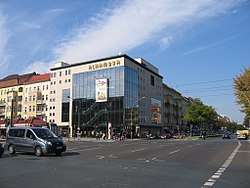 Junction of See- and Müllerstraße with Alhambra cinema | |
 Coat of arms | |
Location of Wedding in Mitte district and Berlin 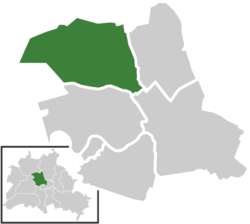 | |
 Wedding  Wedding | |
| Coordinates: 52°33′00″N 13°22′00″E | |
| Country | Germany |
| State | Berlin |
| City | Berlin |
| Borough | Mitte |
| Founded | 1861 |
| Area | |
| • Total | 9.23 km2 (3.56 sq mi) |
| Elevation | 52 m (171 ft) |
| Population (2016-12-31) | |
| • Total | 84,890 |
| • Density | 9,200/km2 (24,000/sq mi) |
| Time zone | CET/CEST (UTC+1/+2) |
| Postal codes | (nr. 0105) 13347, 13349, 13351, 13353, 13355, 13357, 13359, 13407 |
| Vehicle registration | B |
History
In the 12th century, the manor of the nobleman Rudolf de Weddinge was located on the small Panke River in the immediate vicinity of today's Nettelbeckplatz. The farmstead, which burned down more than once, remained abandoned in the forest until the 18th century. In the mid-18th century, while Gesundbrunnen was being built up as a health resort and spa town, gambling and prostitution moved into Wedding, transforming it into a pleasure district. In 1864, Ernst Christian Friedrich Schering established the Schering pharmaceutical company on Müllerstraße; the company has been a part of Bayer since 2006. A large hospital at the western rim of the locality was built between 1898 and 1906 on the initiative of Rudolf Virchow. The Rotaprint plant was initiated in Wedding in 1904 and became one of the largest employers locally with about 1,000 staff at its height.[1]

The constant migration of country-dwellers into the city at the end of the 19th century converted Wedding into a working-class district. The labourers lived in cramped tenement blocks, many in the Wilhelmine Ring. After World War I, Wedding was known as "Red Wedding" as it was renowned for its militant, largely Communist working class; it was the scene of violent clashes between Communist and Nazi sympathizers in the late 1920s, including the Blutmai riots of 1929.[2]
After World War II, Wedding and Reinickendorf together made up the French sector of Berlin. The buildings on the north side of Wedding's Bernauer Straße and the street, including sidewalks, were in the French sector, while the buildings along the southern side were in Soviet territory. When the Berlin Wall was being built in August 1961, many who lived in these buildings frantically jumped from their windows before the buildings could be evacuated and their windows bricked up.
Wedding was also the western terminus of one of the first refugee tunnels dug underneath the Berlin wall. It extended from the basement of an abandoned factory on Schönholzer Straße in the Soviet sector underneath Bernauer Straße to another building in the west. Though marvellously well constructed and kept secret, the tunnel was plagued by water from leaking pipes, and had to be shut down after only a few days of operation.
A section of the wall has been reconstructed near the spot on Bernauer Straße (since 2001 part of the locality of Gesundbrunnen) where the tunnel ended. Two sections of wall run parallel to one another down the street with a "death strip" in the middle. A nearby museum documents the history of the wall.
Wedding today
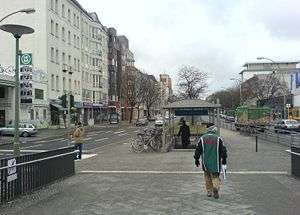
Today, Wedding is one of the poorest areas of Berlin, with a high unemployment rate (almost 26%). Almost 17% of the population live on social welfare; 27% live below the poverty line.[3] Foreigners make up 30% of the population.[4] Low rental costs accompany the poverty in Wedding. Therefore, like many inexpensive areas in large cities, it is home to a vibrant artists' community. Many galleries have been founded by artists to provide a space for themselves and their peers to showcase their works.
Wedding has so far not experienced the boom and development of the 1990s in Berlin. Unlike many other 19th-century working class districts like Prenzlauer Berg, the original character of Wedding has been mostly preserved. Recently, however, more and more students and artists have moved to Wedding due to lower rental costs and a fairly high level of quality of life. As a result, many new Bohemian cafés, restaurants and clubs, organic food stores and markets have been established, an art-house cinema and an urban gardening project has successfully started and high-brow galleries have discovered that area.[5][6][7][8] It is still said though to be a place to find the Schnauze mit Herz (big mouth and big heart) of the Berlin working class.
Demographics
Along with Kreuzberg, Wedding is one of the most ethnically diverse localities of Berlin. The multicultural atmosphere is visible in the bilingual shop signs (predominantly German and Turkish or German and Arabic).
In recent years Wedding has seen a significant influx of Africans, many of whom have settled in the Afrikanisches Viertel, or African Quarter. Wedding is also home to an East Asian community, mostly from China, which is reflected in many Asian and African stores and restaurants. As of 2011, the ethnic make-up of Wedding was 52% of German origin, 18% Turks, 6% Sub-Saharan African, 6% Arabs, 6% Polish, 5% former Yugoslavia, and 4.5% Asian.
Cityscape
Many buildings are relics of European post-war Modernism. The Schillerpark estate in northern Wedding is part of the Modernist Housing Estates World Heritage Site. Beside monolithic housing blocks, several old buildings survived the war and urban renewal and still have coal-fired heating.
A green oasis marks the west borders of the "old red" district, with Volkspark Rehberge, Goethepark and the idyllic Plötzensee, a lake in the southwest. It is a popular summer hang-out offering sandy beaches and long lawns. A section of the beach is reserved for Freikörperkultur, a German nudist movement.
Near Scharnweberstraße 158/159 is Germany's last inner-city dune dating back to the last Ice Age.[9]
Notable people
- Kevin-Prince Boateng, footballer for the Ghana national football team and Schalke 04, grew up in the area.[10]
- Thomas Dörflein (1963–2008), Zookeeper, best known for raising Knut the polar bear.
- Otto and Elise Hampel, a working-class couple who created a simple method of protest while living in Wedding, Berlin during the early years of World War II. They were eventually caught, tried, and executed.
- Hardy Krüger (1928), actor
- Erich Mielke, longtime head of the East German Secret Police.
- Silvia Rodgers, writer and political activist[11]
Photo gallery
- Wedding City Hall
 Protestant old Nazareth Church (by Schinkel) on Leopoldplatz
Protestant old Nazareth Church (by Schinkel) on Leopoldplatz
.jpg) Protestant Capernaum Church on Seestraße
Protestant Capernaum Church on Seestraße_2008.jpg) Lessing-Gymnasium high school
Lessing-Gymnasium high school
- Schillerpark housing estate (by Bruno Taut) on Bristolstraße
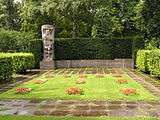 Cemetery and Memorial for the Victims of the Uprising of 1953 in East Germany
Cemetery and Memorial for the Victims of the Uprising of 1953 in East Germany
- Typical houses in Wedding at Leopoldplatz
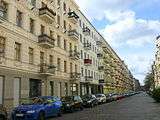 Typical houses in Wedding, Oudenarder Straße
Typical houses in Wedding, Oudenarder Straße
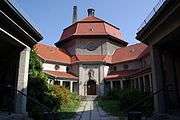 Former crematorium is today an art gallery
Former crematorium is today an art gallery Osramhöfe, former lightbulb plant, now used for various commercials
Osramhöfe, former lightbulb plant, now used for various commercials
Literature
- Komander, Gerhild: Der Wedding – Auf dem Weg von Rot nach Bunt. Berlin Story Verlag, Berlin 2006, ISBN 3-929829-38-X.
- Schmiedecke, Ralf: Berlin-Wedding – Neue Bilder aus alter Zeit. Sutton, Erfurt 2005, ISBN 3-89702-866-2 (Reihe Archivbilder).
- Simon, Christian: 750 Jahre Wedding – Eine Chronik. Berlin 2001, ISBN 3-8311-1777-2.
- Werning, Heiko: Mein wunderbarer Wedding. Geschichten aus dem Prekariat. Edition Tiamat, Berlin 2010, ISBN 978-3-89320-143-3.
- Scheer, Regina: Den Schwächeren helfen, stark zu sein. Die Schrippenkirche im Berliner Wedding 1882–2007. Hentrich & Hentrich Verlag, Berlin, ISBN 978-3-938485-63-7.
References
- Brahm, Daniela. "The Location". ExRotaprint. ExRotaprint gGmbh. Retrieved 10 July 2016.
- Marhoefer, Laurie. "How Should We Protest Neo-Nazis? Lessons from German History". Salon. Retrieved 29 August 2017.
- August 2004, MieterEcho 305. Accessed 2012-11-09.
- Statistik Berlin Brandenburg, September 2011, Statistischer Bericht: Einwohnerinnen und Einwohner im Land Berlin am 30. Juni 2011. Accessed 2012-11-09
- Cafes/Bars/Clubs i.e. are Tassenkuchen, Auf der Suche nach dem verlorenen Glück, Mueslicorn and Candy, Jää-äär / Panke, Analog Bar, Jatz Bar, Moritz / Stattbad, Brunnen70, Club Humboldthain, Anita Berber.
- Restaurants: Volta, Da Baffi, Göttlich etc.
- Urban gardening project Himmelbeet – http://himmelbeet.com
- Gallery Ebensberger at old crematorium – http://www.ebensperger.net/ | Uferstudios, center for contemporary dance – http://www.uferstudios.com/home-en-US/
- "Eiszeit im Wedding – Letzte innerstädtische eiszeitliche Düne Deutschlands wieder sichtbar". berlin.de. 2012-02-16. Retrieved 2019-12-10.
- "The Boateng Brothers' World Cup Duel". Spiegel Online. 16 April 2010. Retrieved 26 January 2012.
- Seaton, Jean (9 October 2006). "Silvia Rodgers". The Guardian. Retrieved 20 February 2019.
